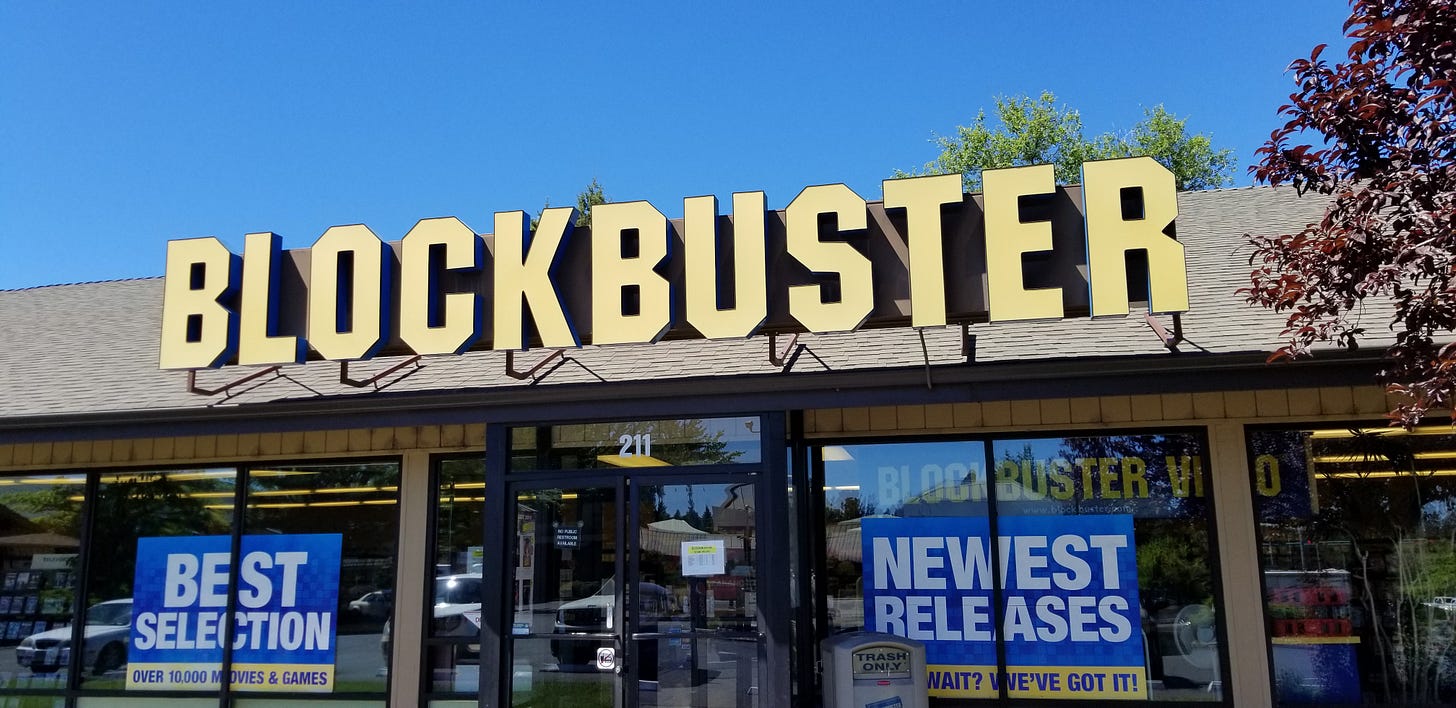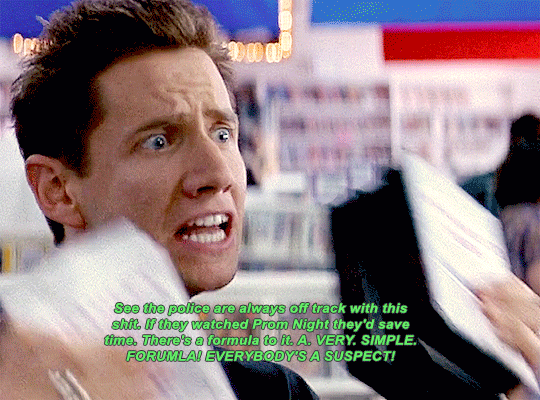
This documentary was released in 2020. I only learned about it yesterday, and totally by the coincidence of seeing a tweet (retweet rather) from Bill Arceneaux.


This quaint Oregonian town has been in my (erm, Facebook) consciousness lately thanks to the Bend Film Festival, where Derek Sitter’s 21-minute film, Bugtussle (2022), has now made its world in-theaters premiere. (Sitter is a longtime Bend resident and business owner, as is his co-producer on the film, Taylor Morden. Morden is director/editor/producer of The Last Blockbuster.) What is this place called Bend, and why is it the last place on earth where a Blockbuster Video is still up and running? Why, moreover, do I care so much? How is it even possible to run a video store in 2022, a time by which DVDs are obsolete?
Are they, though? Obsolete? It may be surprising to some, but the easy answer is, no, they are not quite obsolete. Not yet, anyway. Come on, any shopper at Target and Walmart can see these things still on sale; any public library user can see people checking them out. That is real; it’s happening, here and now, not just in your imagination. There are some places in the world where the internet is not very strong, if it even exists at all. There are also some people who just don’t like to use anything but DVDs—either because they’re old, or poor, or just don’t want to let go of their DVD collections. In Bend, people actually have the option to go to a store just like we all did in the ‘80s, and ‘90s, and the opening years of the new millennium.
When I was a kid, Blockbuster was a big deal. Going to a Blockbuster with my mom or adopted dad and maybe a friend or two on a Friday night was a big deal. We could pick out a movie to watch, anything we wanted, as long as it wasn’t worse than PG13. (Honestly, I grew up in a liberal household, where the “restrictions,” as they existed, were fairly loose, and more out of respect for my friends’ parents than anything else. “If it’s ok with so-and-so’s parents, then it’s ok with us,” was generally the answer at my house.) It was always a thrill to crack open that Blockbuster VHS case and pop that thing into the VCR, and listen to it come alive, all the cranks and wheels turning. Do I remember my first one? Sadly, no. A lot of times, they were scary movies which my friend Heather highly encouraged our mutual obsession with. When I was 13, The Godfather Part III came out and I really wanted to see it, but none of my friends’ parents would let them go see it. My mom, though, she not only took me to see it, she watched the first two with me beforehand. I think we got through both films in one afternoon—the sun shining outside and the two of us hugging pillows on the bed for this highly charged cinematic experience. The gamut—emotional upheaval and psychological turmoil! What better way to experience that than with your mother at your side, explaining everything as you go? Explaining all the contradictions, the quagmires, and the symbolism? To me it was a crucial opening—a window to an awareness of a culture, of customs and values, so different and yet in some ways so alike. It was a window that I kept opening, not only with that particular series (over and over again) but with so many other things.
Ironically, Netflix is the window by which the Last Standing Blockbuster video store has entered into the consciousness of more people. Netflix, the streaming mammoth widely (but unfairly)1 perceived as the single reason for Blockbuster’s downfall! Since the documentary first aired on Netflix on March 15 last year, support for the store in Bend has grown exponentially.2 The film taps into the well of wistfulness that lives in all of us and it got me thinking deeply both as a person who loves to look backward and as a student librarian. One of my classes this semester happens to be Special Collections. What, you might ask innocently, is a Special Collection? Well, quite simply, it’s a collection of something that holds value for the collector—stamps, coins, baseball cards. The Library of Congress has many such special collections. There are dedicated special collections like the British Queen Mary’s Dolls’ House, within the special collection that is the Royal Collection. There’s the Jefferson R. Burdick Collection of sports trading cards at the Met in New York. Pop culture permeates the special collection as much as it does for every other aspect of life. Cornell University has a Hip Hop Collection—shout out to the Twitter @CornellHipHop. The proprietor of the last standing Blockbuster Video, Sandi Harding, is essentially doing the work of a special collection librarian. She is curating a collection of merchandise—DVDs for sure, but also bizarre things like Russell Crowe’s costume accessories from his hit films which, according to a humorous story retold in the documentary, the actor sold to John Oliver, who then donated the assortment—at the time consisting of Crowe’s jockstrap in Cinderella Man (2005)—to a Blockbuster franchise in Alaska.3 (After the closure of the Alaskan franchise, that store donated the memorabilia, minus the jockstrap, to what is now in consequence the Last Standing Blockbuster.) It was fascinating for me as a student librarian to watch Harding on her shopping rounds, buying movies at Target and Walmart to add to the shelves at her Little Blockbuster that Could. She said that she also buys films, especially harder-to-find ones, through online retailers, notably Amazon of course. This is not just a small business owner’s work. This is a librarian’s daily task. This is the hands-on, never-done work of curating. At some point, DVDs may become truly obsolete. They are expensive to produce and there is a dwindling, increasingly niche market for their demand. Yet, just think of all the movies that are lost on VHS because they haven’t been converted yet. We don’t care about everything, and some people will not care about any of it being lost, but if we can preserve some record of something that happened, there will be someone, somewhere who will find value in it. The special collection is the window. The curator keeps it open, clears the cobwebs, helps you navigate the room, and makes decisions about what to keep in the room, what to add, what to subtract based on the public’s interest. The Last Blockbuster is no different than a library in that it exists for the people who use it. You pay to borrow, that’s true, but borrowing is borrowing, and you belong to a club either way. You pay the store with your dollars; they in turn give you movies to watch, rewatch, movies to love, movies to hate, or movies to just laugh at. Movies that make you smile. Movies that make you cry. Movies that make you laugh and cry.
My last memory of being inside a Blockbuster is not a positive one. I think it happened during the “no late fees” fiasco, well-covered as that is in the documentary. It wasn’t long after that that I became a Netflix subscriber and never looked back. (And that brings up nostalgia too, let’s face it! The excitement of getting that envelope in the mail, the simplicity of returning it by the same barcoded means. And what about RedBox? We still see them at every CVS, forlorn and unused, apparently relegated to the fate of telephone booths and police boxes.)
As for the movie itself, while this article is not meant to be a review, either formal or informal, I do feel inclined to rate it highly. The writing by Zeke Kamm is faultless as far as I’m concerned. Under the direction of Taylor Morden, it comes together in nearly an hour-and-a-half narration with interviews and cameos that feature lots of nostalgic goodies for both Generation X and Millennials. I loved the appearances by Jamie Kennedy, whose part in the Scream franchise you might remember as lovable, horror-film-formula expert Randy.4 The narration and cinematography covered all the essential bases and then some: We got the business side of the story, the economic arguments, the sentimental journey, and the human interest to boot, for Sandi Harding is not only the boss lady who has kept it all going; she is, well, as she herself put it, the Blockbuster Mom.

Kenny, Glenn. “‘The Last Blockbuster’ Review: All the Nostalgia With No Late Fees.” The New York Times. December 15, 2020. https://archive.ph/jKnsv.
Associated Press via the Peoria Journal Star (Peoria, IL), April 4, 2021. https://www.pjstar.com/story/entertainment/2021/04/04/last-blockbuster-netflix-documentary-offers-nostalgia/4809782001/. Archived: https://web.archive.org/web/20210404112124/https://www.pjstar.com/story/entertainment/2021/04/04/last-blockbuster-netflix-documentary-offers-nostalgia/4809782001/.
Spurr, Kyle. Bend Filmmakers document the last Blockbuster. The Bulletin (Bend, OR.) September 19, 2018. https://www.bendbulletin.com/localstate/bend-filmmakers-document-the-last-blockbuster/article_adb2bcbf-1d62-5b80-8574-49c8d044ba37.html. Archived: https://web.archive.org/web/20181121203726/https://www.bendbulletin.com/localstate/6532038-151/bend-filmmakers-document-the-last-blockbuster.
Tumblr User: scaredyjack. “31 Days of Halloween: Day 4 + Scream (1996).” https://at.tumblr.com/scaredyjack/31-days-of-halloween-day-4-scream-1996/z9291sta62u8.



